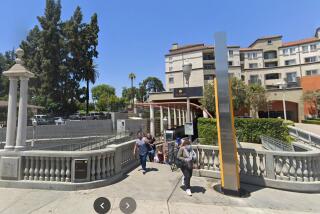Ghost Subway Stop Looks Back to Future
- Share via
NEW YORK — Fifty yards from City Hall and 35 feet below it lies a long slow curve into New York’s past. It is a subway station that recalls a time when underground train rides were trips into the future and when terra cotta, not stainless steel, was the underground vogue.
Few of the city’s daily 10 million subway riders have ever seen or heard of the City Hall Station, which was the last stop on the city’s first subway line, the Interborough Rapid Transit. Since 1948, passengers have had to get off at the larger but more plain Brooklyn Bridge stop.
City Hall Station is a ghost station. Its brass chandeliers and vaulted ceilings are for the most part seen only by engineers and conductors who guide their trains through the station from the downtown to the uptown track.
There are five ghost stations in New York, but none so historically significant or remarkably well preserved.
“Each time I go by, it’s like going into the past,” said John Morton, a driver for 16 years.
On Oct. 27, 1904, New York’s 93rd mayor, John McClellan, descended the steps of one of two kiosks marking the station’s entrance in City Hall Park. Then taking a silver key from an engineer, he switched on the electricity and drove the first train out of the station to the wild cheering of passengers as well as above-ground crowds.
Because of its location literally at the foot of New York’s government, City Hall was the crown jewel among the IRT’s original 49 stations. Aside from its chandeliers and cream-colored matte ceiling tiles, it featured three skylights of tinted glass and station name plaques of blue and white glazed tile.
Work on the original IRT lasted almost five years and cost $35 million. The line stretched from the City Hall Station north to Grand Central Terminal, west to Times Square and then north again to 145th Street in Manhattan. One newspaper reported that although New Yorkers were a little mystified at seeing people emerge from underground stations, they quickly embraced their subway, as more than 150,000 people went for a ride on opening night.
But in 1948, the city’s transit authority decided to end service to City Hall Station. It said that the extreme curve of the station, which created gaps of one to two feet between trains and the platform, was a hazard for passengers. Trains would continue to use its tunnel to turn around, but Brooklyn Bridge, which despite its name lies roughly the same distance from City Hall, became the last stop on the No. 6 line.
In contrast to the opening ceremony, City Hall Station closed without fanfare on the stroke of the new year. New York’s newspapers barely made note of its passing.
Citing its historical importance and beautiful tile work, New York’s Landmarks Commission made City Hall Station a landmark on Oct. 29, 1979. Michael Corbett, a commission researcher, said landmark structures are “customarily open to the public.”
Tour groups cleared by the Transit Authority are now the only passengers permitted to see the station.
Bob Previdi, a spokesman for the Metropolitan Transit Authority, said that the agency had considered opening City Hall to the public, possibly as a restaurant, but that the station’s narrow platforms and poor plumbing presented formidable obstacles.
Melanie Crawford, a traffic controller for the No. 6 line, said that she was proud to have the station under her jurisdiction. “You get a feeling of history,” she said.
The gloominess of the station easily evokes memories of the past. Two of the three skylights have been blocked. Only the lights from the chandeliers--12 in all with four bulbs each--illuminate the platform. A short flight of stairs up from the platform, 12 more bulbs provide light for the small mezzanine.
The tile work is marred only by a small chip over one of the nameplates, and some graffiti. Marvin Capers, a former train engineer who leads tours of the station, said it is cleaned regularly.
“Look at how the work has held up,” he said. “If you built something like this today, the tiles would be gone.”
More to Read
Sign up for Essential California
The most important California stories and recommendations in your inbox every morning.
You may occasionally receive promotional content from the Los Angeles Times.













